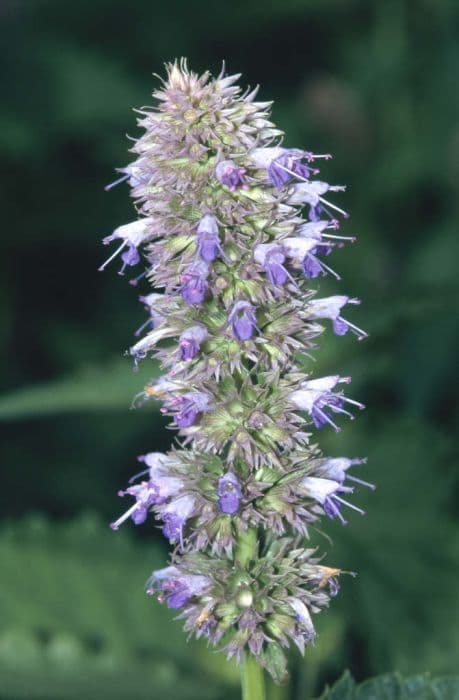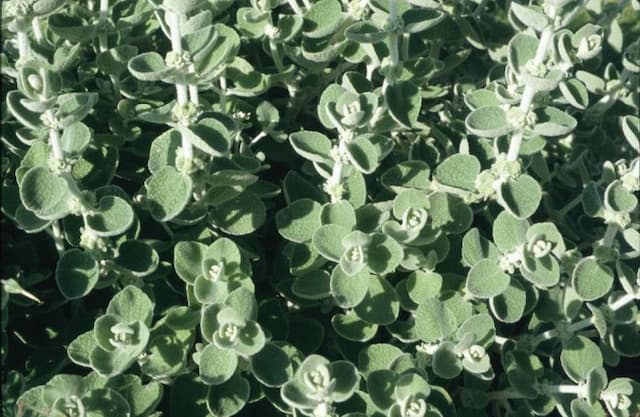Black and Bloom Salvia Salvia Black & Bloom = 'Balsaloom'

ABOUT
Salvia Black & Bloom, also known as "Black & Blue Sage," is a striking ornamental plant prized for its vibrant flowers and lush foliage. Its striking appearance comes from its deep blue to purplish flowers, which emerge from black calyxes, creating a sharp contrast that's both bold and visually arresting. The blossoms are tubular and tend to be densely packed in whorls along the flower spike, attracting hummingbirds and butterflies to the garden. The foliage of Black & Blue Sage is equally attractive, composed of dark green leaves that have a slightly wrinkled texture and a somewhat lance-shaped or oval contour. The leaves often have serrated edges, and they release a pleasant scent when brushed or crushed, adding a sensory experience to the garden. Overall, Salvia Black & Bloom's richly colored flowers and aromatic foliage make it a standout in any sunny to partly shaded landscape, offering a prolonged season of interest with its long-lasting blooms. It typically presents a bushy and upright habit, contributing both structure and color to planting beds, borders, or containers where it is grown.
About this plant
 Names
NamesFamily
Lamiaceae.
Synonyms
Black & Bloom Sage, Salvia 'Balsaloom'.
Common names
Salvia guaranitica 'Balsaloom'.
 Toxicity
ToxicityTo humans
Salvia 'Black & Bloom' is generally considered non-toxic to humans. However, as with any plant, individual sensitivity can vary, and it's not recommended to consume any part of ornamental varieties as they are not meant for human ingestion. There may be instances of gastrointestinal upset or allergic reaction if ingested, but significant toxicity is not typically associated with this plant.
To pets
Salvia 'Black & Bloom' is also generally non-toxic to pets. As with humans, ingestion can sometimes lead to mild gastrointestinal upset such as vomiting or diarrhea in some pets. If your pet has ingested this plant and is showing adverse symptoms, it is advisable to consult with a veterinarian. However, serious toxicity is not expected from ingesting this plant.
 Characteristics
CharacteristicsLife cycle
Perennials
Foliage type
Semi-deciduous
Color of leaves
Green
Flower color
Blue
Height
2-3 feet (60-90 cm)
Spread
2-3 feet (60-90 cm)
Plant type
Herb
Hardiness zones
8-11
Native area
Cultivar
Benefits
 General Benefits
General Benefits- Attracts Pollinators: 'Black & Bloom' salvia draws bees, butterflies, and hummingbirds to the garden, helping to pollinate flowers and contributing to the health of the ecosystem.
- Low Maintenance: This plant is hardy and requires minimal care once established, making it a convenient choice for gardeners of all levels.
- Drought Tolerant: Salvia 'Black & Bloom' is drought-resistant, which is beneficial in water-scarce areas or for gardeners looking for water-wise plants.
- Long Blooming Season: It has a long flowering period from spring through fall, providing vibrant colors and interest in the garden for an extended time.
- Deer and Rabbit Resistant: The plant is generally resistant to deer and rabbit browsing, reducing the need for protective measures.
- Attractive Foliage: 'Black & Bloom' features striking dark stems with deep blue flowers, adding aesthetic value to landscapes and decorative gardens.
- Heat Tolerant: Salvia 'Black & Bloom' can thrive in hot climates, expanding the range of environments in which it can grow.
- Versatile: This salvia can be used in various garden designs, including borders, container gardening, and as focal points.
- Soil Adaptability: It is able to adapt to a wide range of soil types, although it prefers well-draining soil.
- Fast Growth: The plant grows quickly, allowing gardeners to enjoy its benefits soon after planting.
 Medical Properties
Medical PropertiesThis plant is not used for medical purposes.
 Air-purifying Qualities
Air-purifying QualitiesThis plant is not specifically known for air purifying qualities.
 Other Uses
Other Uses- Eco-friendly Dye: The deep blue to purple flowers of Salvia Black & Bloom can be used to create natural dyes for textiles, offering an eco-friendly alternative to synthetic dyes.
- Ink Production: The pigments from the flowers can also be used to make inks for writing and drawing, providing a distinctive color derived from nature.
- Craft Decoration: Dried flowers of Salvia Black & Bloom can be incorporated into various crafts, such as scrapbooking or the creation of floral displays and wreaths.
- Educational Tool: The plant can serve as an educational tool to teach about pollination, as it attracts bees, butterflies, and hummingbirds.
- Photography Subjects: Due to their striking appearance, the plants can be used as excellent subjects for botanical and garden photography.
- Culinary Garnish: The striking flowers can serve as an edible garnish for salads and desserts, adding color and a mild sage flavor.
- Artistic Inspiration: Artists can draw inspiration from the vibrant colors and forms of the Salvia Black & Bloom for various forms of artwork.
- Thematic Garden Design: The dramatic appearance of the plant can be utilized in creating themed garden designs, such as gothic or midnight gardens.
- Aromatherapy: The subtly fragrant leaves can be incorporated into homemade potpourri or aromatherapy sachets, contributing to a calming environment.
- Plant Stamping: The leaves can be used to create botanical prints on paper or fabric, through a technique known as plant stamping or hammering.
Interesting Facts
 Feng Shui
Feng ShuiBlack and Blue Sage is not used in Feng Shui practice.
 Zodiac Sign Compitability
Zodiac Sign CompitabilityBlack and Blue Sage is not used in astrology practice.
 Plant Symbolism
Plant Symbolism- Healing: Salvia plants are often associated with healing because of their widespread use in herbal medicine to treat a variety of ailments.
- Wisdom: The name Salvia is derived from the Latin word ‘salvere’, which means ‘to save’ or ‘to heal’, and has been connected to wisdom and knowledge.
- Longevity: The enduring nature of some Salvia species, as well as their use in traditional medicine for promoting long life, lends them symbolic meaning for longevity.
- Protection: Some cultures use Salvia plants in rituals or keep them in homes to ward off evil and provide protection due to their strong scent and purported cleansing properties.
 Water
WaterBlack and Blue Sage requires consistent moisture, especially during hot and dry conditions. Watering should be deep, allowing the soil to become moist without becoming waterlogged; on average, this may involve providing approximately 1 gallon of water per plant per week. During peak summer heat, the frequency may increase to twice a week. It's best to water at the base to avoid wetting the foliage, which can lead to fungal diseases. Allow the top inch of soil to dry out before watering again to encourage strong root growth.
 Light
LightBlack and Blue Sage thrives best in full sun to partial shade conditions. The ideal spot for this plant would have direct sunlight for at least 6 to 8 hours a day. If grown indoors, a south-facing window is a good location to provide ample sunlight. However, in very hot climates, some afternoon shade can help prevent the plant from getting too stressed by the intense heat.
 Temperature
TemperatureBlack and Blue Sage flourishes in a temperature range between 50°F and 85°F. It can tolerate minimum temperatures down to around 40°F but should be protected from frost, which can damage or kill the plant. It cannot survive in temperatures that consistently drop below freezing. The ideal conditions for this sage are moderate temperatures with cool nights and warm days.
 Pruning
PruningPruning Black and Blue Sage is important to encourage bushier growth and more blooms. Trim off spent flower spikes to stimulate new blooms. It's best to prune in late winter or early spring before new growth starts, cutting back the plant by about one-third to one-half its size. Pruning can be done again lightly throughout the growing season to maintain the desired shape and size.
 Cleaning
CleaningAs needed
 Soil
SoilThe best soil mix for Salvias, also known as Black and Blue Sage, should be well-draining and fertile. A combination of garden soil, compost, and perlite or coarse sand can create a good environment for the roots, ensuring they have access to necessary nutrients without becoming water-logged. The ideal soil pH for Salvias is slightly acidic to neutral, ranging from 6.0 to 7.0.
 Repotting
RepottingSalvias, including Black and Blue Sage, generally need repotting every 12 to 18 months, mainly if they have outgrown their current container or the soil has become compacted. Check the root system in the spring and repot if necessary to give your plant space to continue growing healthily.
 Humidity & Misting
Humidity & MistingBlack and Blue Sage prefers a moderate humidity level but is quite adaptable and can tolerate the dry air commonly found in home environments. It does not require any special humidity requirements, making it easy to care for in most indoor settings.
 Suitable locations
Suitable locationsIndoor
Ensure bright light and good air circulation for healthy indoor growth.
Outdoor
Place in full sun to partial shade and protect from harsh winds.
Hardiness zone
Black and Blue Sage falls within the USDA hardiness zones of 7-10.
 Life cycle
Life cycleBlack & Blue Sage (Salvia 'Balsaloom') begins its life cycle with the germination of seeds, typically in the warmth of spring or early summer. After sprouting, the seedlings develop into young plants with characteristic bright green foliage. As the plants mature, they grow larger and form robust stems with deep green leaves. During the blooming season, which generally occurs in late spring through fall, Black & Blue Sage produces striking blue to purplish flowers with black calyxes, attracting pollinators such as bees, butterflies, and hummingbirds. The plant continues to bloom throughout the growing season, with proper care and deadheading of spent flowers to encourage reblooming. As temperatures cool and the growing season ends, the plant becomes dormant, often dying back in climates with frost, to then re-sprout from the roots or self-seeding the following spring, completing its life cycle.
 Propogation
PropogationPropogation time
Spring-Early Summer
Salvia 'Black & Bloom', commonly known as Black & Blue Sage or Salvia 'Balsaloom', is best propagated through stem cuttings, which is the most popular method for this plant due to the ease and effectiveness of the technique. Typically, the ideal time for taking cuttings is late spring to early summer when the plant is actively growing and the stems are mature yet still somewhat flexible. To propagate, select a healthy, non-flowering stem and cut a 4 to 6-inch (10-15 cm) segment just below a node, where leaves emerge. Remove the leaves from the lower half of the cutting and dip the cut end in rooting hormone to encourage root development. Plant the cutting in a well-draining soil mix, ensuring at least one or two nodes are buried where roots can form. Keep the soil consistently moist but not waterlogged and place the cutting in bright, indirect light. Roots typically establish within a few weeks, after which the new Salvia can gradually acclimate to outdoor conditions before being planted in the garden.









